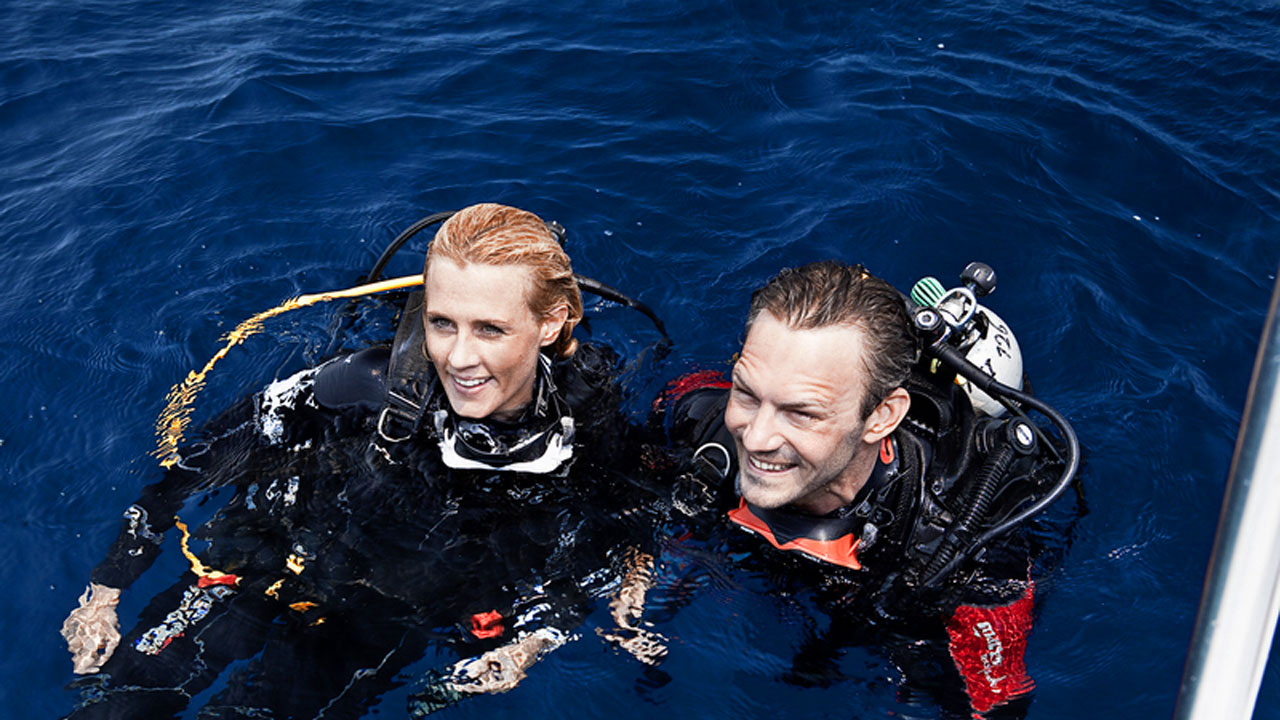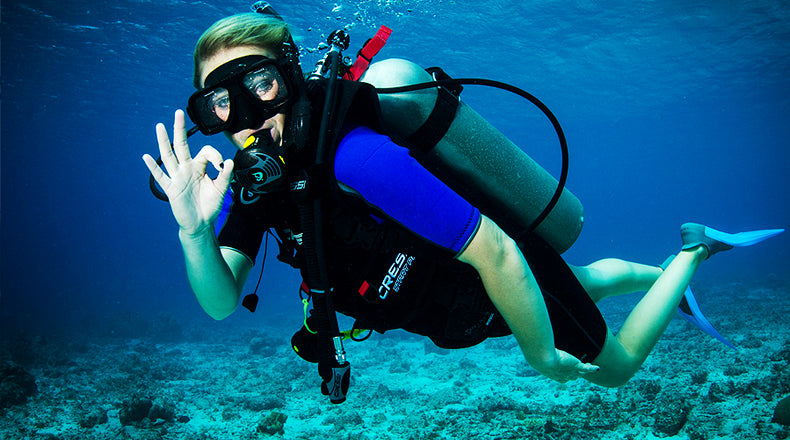Scuba Basics: Water Entry Methods

Every diver learns at least one water entry technique during their Open Water course. However, as they start diving in different conditions, they inevitably discover that there are actually several ways to get into the water. Most of the time the diver can simply choose the method he or she is comfortable with. In some cases though, there is no choice and the strategy needs to be selected based on the situation. So, let us take a look at five of the most common methods of water entry for scuba divers.
The Giant Stride
The most common scuba diving entry method is called the giant stride. It is pretty much what the name implies: a big step into the water. Here is how to perform it correctly.
- With all of your gear on, regulator in your mouth, and BCD halfway inflated, stand on the edge of the platform so that the tips of your fins are hanging over the edge.
- Check if the water is clear of any other divers or potential hazards. Look both directly below you and to the sides to make sure no diver is going to swim into your entry zone.
- Place your hand over your regulator and fingers over your mask to make sure they stay in place when you hit the water.
- Place your other hand either on the buckle of your weight belt, if you are wearing one, to prevent it from opening, or on the back of your head to hold your mask strap.
- Stand straight and look toward the horizon. This will help you step far enough away from the platform not to hit the back of your tank on the boat.
- When you are ready, take a big step forward with one foot and you will have completed the Giant Stride Entry.
- Don’t forget to signal to the boat that you are okay by putting your fist on your head or giving the okay sign with your hand.
Best used when: entering deep water from a stable platform, such as a deck of a larger dive boat or liveaboard. This method can also be used to step off a pier or jetty if the water is deep enough.

The Back Roll
The back roll is another common method used when boat diving. To perform it correctly follow these steps.
- With all your gear in place, regulator in your mouth, and BCD halfway inflated, sit on the edge of the boat, facing inwards. You can cross your ankles to keep your legs together when you make the backward roll.
- Try to scoot as far back as you can without falling over the side.
- Use the palm of your hand to secure your regulator and hold your mask with the fingertips of the same hand.
- Place your other hand on the back of your head to keep the mask strap from slipping off and to stop your head from hitting the cylinder valve.
- When your boat handler gives you the “go”, roll backwards and hit the water. Since your BCD is inflated you will float at the surface.
- If you hesitate and fail to make an entry at the handler’s count, wait for the new countdown before making a second attempt. This will allow the person assisting you to check your entry zone once more.
- Make the ok signal when you are at the surface.
Best used when: entering the water from a small boat, such as the RIB (rigid inflatable boat) or any other small craft whose gunwale is both close to the water and not particularly stable.

The Seated Entry
Although the seated entry is not as commonly used as the giant stride or the back roll, it is easy to perform and can be extremely helpful in certain situations.
- Start by sitting geared up on the edge of a boat or dock with your fins on your feet as they dangle in the water.
- Place both of your hands on the edge next to you.
- Lift yourself up and outward with your hands and lower yourself into the water.
- Try to push your body away from the platform to make sure that you don’t hit yourself or your tank on the side of it.
Best used when: the water is too shallow for a back roll or giant stride and the platform is low enough to perform the maneuver. It is also a good entry method for disabled or senior divers.
Beach Entry
When diving from the shore, you need to assess the conditions and evaluate the surf zone in order to decide how you are going to navigate through it. If the chosen dive site has small or no surf zone, minimal current action and a hazard-free terrain, your entry will be relatively simple.
- Gear up, but don’t put your fins on. Instead, hold them securely with one hand.
- Walk slowly backwards into the water watching that you don't step on anything sharp.
- Once you’re about chest deep, with your BCD inflated, your mask in place and regulator in your mouth, put your fins on.
- Swim backwards with your BCD inflated until the water is deep enough to make your descent.
- Remember to watch your reference point on shore while kicking. This will help you stay on course and determine whether the current is carrying you down the beach. Use that visual reference to find your way back to the entry point when you surface.

Rocky Surface / Heavy Surf Entry
If your entry zone has pounding surf or rough rocks, the entry will be considerably more difficult. The key here is to carefully evaluate the conditions and observe the waves on site. If you decide that they are not manageable, don’t hesitate to call the dive. You can always come back another day when there's less wind, shorter waves or a smaller tidal exchange. Otherwise, perform the following steps.
- Enter the water with your fins and mask already in place, regulator in your mouth and BCD inflated.
- Avoid carrying any extra scuba accessories such as cameras or torches, so that you can keep your hands free to steady yourself. If you absolutely need them, make sure to attach all your accessories securely to your BCD or stow them away in pockets.
- Walk into the water sideways in order to minimize the impact of oncoming waves on your body.
- As soon as you’re deep enough, let all air out of your BCD and descend to the bottom.
- Use your hands to pull yourself to deeper water in coordination with the pull and lull of the waves crashing above you.
- If you get knocked down by a wave in the surf zone, don't attempt to get up. Crawl on all fours or edge your body forward in a seated position, until you are deep enough to start finning.
Apart from the five basic water entry methods shown above, you may encounter several other such as the forward roll, ladder entry or donning you equipment once in the water. As you gain more experience, entry method selection will become almost automatic. Until then, consider the conditions at your dive site and inquire from your divemaster and/or captain as to the method that is used for each vessel.
Stay safe and happy diving!




